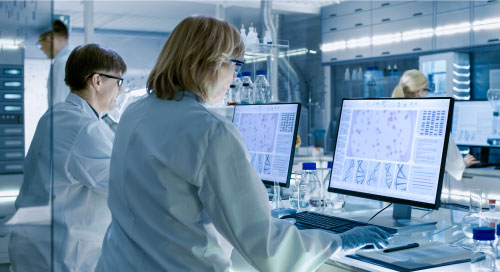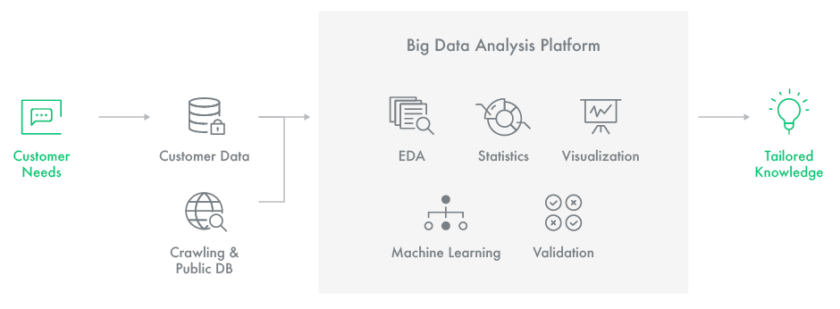AI Uncovers Bioinformatic Treasure in a Sea of Data

There’s a paradox in the world of bioinformatics. The rapid growth of data is creating countless new opportunities—but all this data is useless if researchers can’t make sense of it.
Indeed, this is already a problem. Researchers are spending so much time trying to organize and comprehend the data that little room is left for meaningful discoveries. And the challenges will only increase as technological advances increase the availability of bioinformatic data.
“The field of bioinformatics has rapidly evolved and is indispensable in this current era of big data and fourth industrial revolution. Many areas such as pharmaceuticals, clinical research, disease research, and healthcare industries have to deal with big data. People who work in those areas need a bioinformatics approach to analyze big data,” says Seung-cheon Yong, Senior Consultant for the AI-driven bioinformatics company Insilicogen.
The future of bioinformatics, Yong explains, will rely on artificial intelligence techniques to uncover biological impacts.
A New Approach to In Silico Experiments
Human genome data alone can come from blood, saliva, bone samples, X-rays, and MRIs. Researchers are also collecting data from animals, plants, and microorganisms. This type of data can provide more insights into traits, rare diseases, drug resistance, and personalized nutrition.
But collecting this data can be a slow and tedious process—hence the emergence of in silico research, which uses computer programs to simulate biologic systems and perform scientific experiments. This has been adequate at validating outcomes and visualizing data, but limited in its ability to help researchers analyze, interpret, and comprehend all the data.
The future of #bioinformatics will rely on #ArtificialIntelligence techniques to uncover biological impacts. @insilicogen via @insightdottech
Insilicogen is transforming its in silico approach by working with global partners to incorporate artificial intelligence techniques. Yong says with the use of AI, researchers can gain valuable insights faster without as much time or effort.
“We are living in an age of large-scale data. You can let AI learn from the data and interpret it. Hence, we can get fast and accurate results,” says Yong.
The company implements techniques such as structuring, interconnecting, machine learning, and feature selection and extraction to find hidden value in the data (Figure 1).

Insilicogen’s machine learning models analyze the data structures, assess and refine the data, and perform feature selection and extraction. Deep learning neural nets are used to extract valuable information from text sequences, images, videos, and natural language processing. Insilicogen also leverages its tailored knowledge to provide web-based results, real-time insights, and further develop AI and analysis algorithms.
“As a result, customers can deal with their data and do bioinformatics analysis and research,” says Yong.
AI-Driven Bioinformatics
One area that benefits from applying AI to bioinformatics is the food service industry. For example, the data food company DP, a subsidiary of Insillicogen, combines AI, big data, and bioinformatics to create a customized fruit subscription service.
Fruit Compatibility looks at a user’s biological data such as gender, age, height, weight, blood pressure, blood sugar, and health goals to recommend certain fruits for a healthier living status.
DP is also working with Hanbio Gene Co., Ltd. to launch a food and diet recommendation platform based on individual genetic information and AI.
In addition, Insilicogen helps several other organizations and research institutions apply AI to their biological research. For example, it works with:
- The Korea Institute for Animal Projects Quality Evaluation to help analyze and detect the quality of beef using image analysis and machine learning
- The Korean National Research Institute of Cultural Heritage to establish a machine learning model that predicts termite wood damage
- The Korean National Institute of Fisheries Science to predict the high temperature tolerance of abalone
- The Food Industry Technology Support Center to analyze ingredients based on function, culture, and geographic location
Understanding and Storing Bioinformatical Data
Beyond being able to make worthwhile analysis on bioinformatical data, Yong says there is still a challenge with being able to store and handle the data.
“The technology keeps improving and tons of biological data is being produced, but compute power and capability is insufficient. It’s not good enough,” he says. “Many people don’t know how to handle the data to find answers to clinical or biological questions. In order to overcome these issues, a national supercomputing center or cloud computing system is needed.”
Insilicogen’s partnership with Intel® has enabled the company to provide a high-spec computer with NGS data analysis solutions to customers at an affordable price. “We created business synergy to utilize an Intel solution with high-spec computers and Insilicogen’s technical support to customers,” says Yong.
The company combines its bioinformatic analysis consulting service with Intel to create the Inco X Intel Select Solution designed to process, store, and analyze disease genome sequencing data.
Yong explains Insilicogen is responsible for interpreting and storing more than 60% of South Korea’s bio-big-data.
Educating the Next Generation of Bioinformatic Researchers
According to Insilicogen’s CEO Namwoo Choi, the future of bioinformatics driven by AI requires more experience and understanding of the field.
Insilicogen offers an active bioinformatics education program to help more researchers understand how to use this data for biological research and development.
As part of its on-site human resource training, Insilicogen has experts in data processing, genomics, transcriptomics analysis, and programming. Customers can benefit from basic education programs or programs tailored to their specific needs as well as an online education center, workshops, and hands-on training with bioinformatics and genomic data analysis.
“The future of bioinformatics is promising. There are thousands of data sets that need data mining and bioinformatics analysis. Insilicogen understands the situation, and we will keep providing bioinformatics analysis support, education, and collaboration with other global/local companies to create a solution based on future needs,” says Yong.